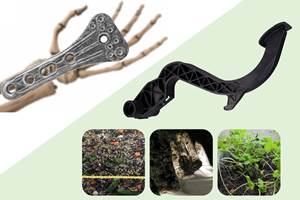Cooperating on new-generation ground transport
ÂÌñÏ×ÆÞ's editor-in-chief Jeff Sloan shares his observations about the mixture of excitement and anxiety about the future of composite in the auto industry on display at the recent Thermoplastics Composites Conference for Automotive (TCCA), held in the Detroit suburb of Novi, MI, US.
We composites professionals look at the automotive market with a unique combination of excitement and anxiety. The excitement grows out of the knowledge that the auto industry has a mandate to lose weight, and composites are an obvious choice to help get that done.
The anxiety grows out of uncertainty: What materials will be used — composites? Aluminum? New light steel? How and where will they be applied? Which OEMs will apply them? How will composites fit into the automotive supply chain?
And, frankly, we should chalk up some of our anxiety to the old adage, “Be careful what you wish for.” That is, depending on how composites are applied in the automotive market, some suppliers and fabricators might struggle to meet what could be substantial and unrelenting demand for composite materials and parts.
There is some irony in this. The composites industry has coveted mainstream automotive applications for so long that it seems to me we are like the persistent, pesky salesman, talking up his products’ litany of benefits as he shops his wares to automotive OEMs around the world, trying to get his foot in the door and prove they can do the job.
But this is an unfair analogy. It’s not fair to the composites indus-try or to automotive OEMs. The truth is that composites will not be sold into an automotive program. Composites will earn their way into automotive programs, and only because they meet a specific structural or aesthetic need cost-effectively.
I was reminded of this forcefully this week (it’s June 17 as I write this) at ÂÌñÏ×ÆÞ’s Thermoplastics Composites Conference for Automotive (TCCA), in the Detroit suburb of Novi, MI, US. I was a conference co-chair, along with Matt Naitove, executive editor, and Lilli Sherman, senior editor, of sister publication Plastics Technology. The conference attracted almost 200 attendees from across the automotive supply chain, who came to see and hear 21 presentations on a variety of material and process tech- nologies aimed at thermoplastic composites for the auto industry. Presentations ranged from the latest on long glass fiber-reinforced thermoplastics to carbon fiber use in compression molding to simulation of chopped fiber orientation in injection molding.
What struck me over the day-and-a-half conference was the variety and quality of the material and process innovation presented, and the intensity of the presenters. These were not salespeople trying to talk a reluctant automotive industry into buying a product. They were technology and material specialists who have listened carefully to what automotive OEMs say they need, and have developed carefully crafted solutions to meet that need.
Some solutions are mature, well-developed and in use today. Others are clearly still in development. All of them, though, are highly targeted and designed to leverage the multi-fiber, multi-resin, multi-process dynamism of the composites industry. Covestro LLC, for instance, announced at the conference that it has begun working on application of fiber-reinforced polycarbonate for the fabrication of Class A automotive body panels. Teijin reported on the status of its compression-molded chopped carbon fiber/polyamide composite material for structural vehicle parts. Sigmatex informed attendees about its efforts to incorporate recycled carbon fiber and thermo- plastic fibers into its reinforcements product line. The Fraunhofer Institute for Chemical Technology (ICT) reported on its work developing sandwich structures with tailored, foam-injected cores. And Autodesk revealed details of its research into simulating weld line behavior in injection molding.
I will report on all of the conference presentations in next month’s CW, but suffice it to say that I was strongly impressed by the creativity, intelligence and forethought represented throughout the conference — on the podium and in the audience.
Ultimately, my takeaway message was this: Material and process specialists throughout the automotive and composites supply chain are working cooperatively and collaboratively to drive weight out of vehicles, increase fuel efficiency, build in sustainability and usher in a new generation of vehicles that promises to reshape transportation. And that’s as good a thing to wish for as I could hope.
Related Content
Partners recycle A350 composite production waste into adjustable-length rods for MFFD
Herone, Spiral RTC, Teijin Carbon Europe and Collins Aerospace Almere recycle A350 thermoplastic composite clips/cleats waste into rods for the all-thermoplastic composite Multifunctional Fuselage Demonstrator’s crown.
Read MoreWatch: A practical view of sustainability in composites product development
Markus Beer of Forward Engineering addresses definitions of sustainability, how to approach sustainability goals, the role of life cycle analysis (LCA) and social, environmental and governmental driving forces. Watch his “CW Tech Days: Sustainability” presentation.
Read MoreLife cycle assessment in the composites industry
As companies strive to meet zero-emissions goals, evaluating a product’s carbon footprint is vital. Life cycle assessment (LCA) is one tool composites industry OEMs and Tier suppliers are using to move toward sustainability targets.
Read MoreBioabsorbable and degradable glass fibers, compostable composite parts
ABM Composite offers sustainable options and up to a 60% reduction in carbon footprint for glass fiber-reinforced composites.
Read MoreRead Next
“Structured air” TPS safeguards composite structures
Powered by an 85% air/15% pure polyimide aerogel, Blueshift’s novel material system protects structures during transient thermal events from -200°C to beyond 2400°C for rockets, battery boxes and more.
Read MoreComposites end markets: New space (2025)
Composite materials — with their unmatched strength-to-weight ratio, durability in extreme environments and design versatility — are at the heart of innovations in satellites, propulsion systems and lunar exploration vehicles, propelling the space economy toward a $1.8 trillion future.
Read MoreAll-recycled, needle-punched nonwoven CFRP slashes carbon footprint of Formula 2 seat
Dallara and Tenowo collaborate to produce a race-ready Formula 2 seat using recycled carbon fiber, reducing CO2 emissions by 97.5% compared to virgin materials.
Read More










